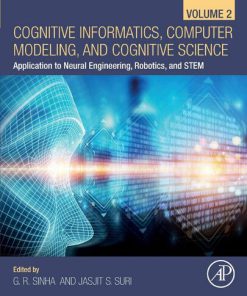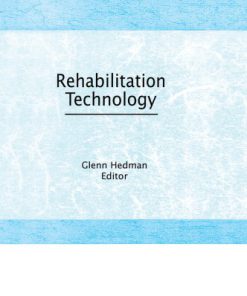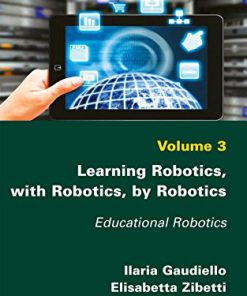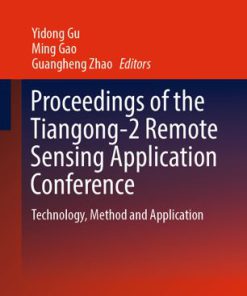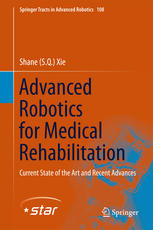Rehabilitation Robotics Technology and Application 1st Edition by Roberto Colombo, Vittorio Sanguineti ISBN 9780128119969 0128119969
$50.00 Original price was: $50.00.$25.00Current price is: $25.00.
Rehabilitation Robotics Technology and Application 1st Edition by Roberto Colombo, Vittorio Sanguineti – Ebook PDF Instant Download/Delivery: 9780128119969 ,0128119969
Full download Rehabilitation Robotics Technology and Application 1st Editionafter payment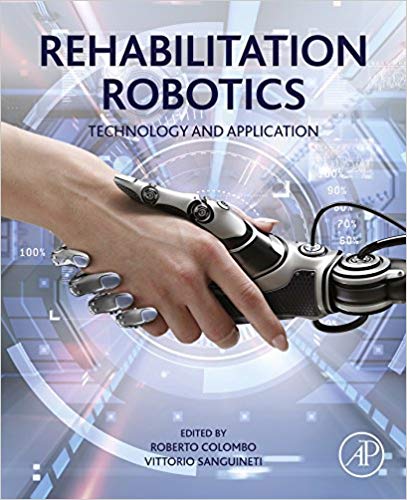
Product details:
ISBN 10: 0128119969
ISBN 13: 9780128119969
Author: Roberto Colombo, Vittorio Sanguineti
Rehabilitation Robotics gives an introduction and overview of all areas of rehabilitation robotics, perfect for anyone new to the field. It also summarizes available robot technologies and their application to different pathologies for skilled researchers and clinicians. The editors have been involved in the development and application of robotic devices for neurorehabilitation for more than 15 years. This experience using several commercial devices for robotic rehabilitation has enabled them to develop the know-how and expertise necessary to guide those seeking comprehensive understanding of this topic.
Each chapter is written by an expert in the respective field, pulling in perspectives from both engineers and clinicians to present a multi-disciplinary view. The book targets the implementation of efficient robot strategies to facilitate the re-acquisition of motor skills. This technology incorporates the outcomes of behavioral studies on motor learning and its neural correlates into the design, implementation and validation of robot agents that behave as ‘optimal’ trainers, efficiently exploiting the structure and plasticity of the human sensorimotor systems. In this context, human-robot interaction plays a paramount role, at both the physical and cognitive level, toward achieving a symbiotic interaction where the human body and the robot can benefit from each other’s dynamics.
- Provides a comprehensive review of recent developments in the area of rehabilitation robotics
- Includes information on both therapeutic and assistive robots
- Focuses on the state-of-the-art and representative advancements in the design, control, analysis, implementation and validation of rehabilitation robotic systems
Rehabilitation Robotics Technology and Application 1st Edition Table of contents:
PART I: Background and Technology
PART II: Applications
Chapter 1: Physiological basis of neuromotor recovery
Abstract
Introduction
The Functional Organization of the Motor Network
Motor Network Activity and Movement
The Physiology of Ischemic Infarctions
Motor Deficits Following Stroke
Motor Network Plasticity Following Infarction
Functional Plasticity Following Infarction
Conclusions and Implications for Rehabilitative Therapies
Chapter 2: An overall framework for neurorehabilitation robotics: Implications for recovery
Abstract
Introduction
Hierarchical Architecture of the Motor System
Functional Synergies
Neural Plasticity and Functional Recovery, After Lesion of the Central Nervous System
The Neurobiology of Motor Skills Acquisition and Learning for Rehabilitation
Rehabilitation Modalities
Characteristics of Successful Strategies for Neurorehabilitation: Clinical Evidence
Conclusion
Chapter 3: Biomechatronic design criteria of systems for robot-mediated rehabilitation therapy
Abstract
Acknowledgments
Introduction
Design Criteria of Biomechatronic Devices for Robot-Mediated Rehabilitation
Modeling the Human Component
Overview of Control Strategies
The CBM-Motus and the LENAR: Two Case Studies
Conclusions
Chapter 4: Actuation for robot-aided rehabilitation: Design and control strategies
Abstract
Introduction
Robot Architectures and Actuators
Control Strategies
Friction and Backlash Compensation
Implications for the Control of Rehabilitation Robots
Conclusion
Chapter 5: Assistive controllers and modalities for robot-aided neurorehabilitation
Abstract
Introduction
Therapeutic Exercises
Assistive Scenarios
Regulation of Assistance
Other Types of Assistance
Conclusions
Chapter 6: Exoskeletons for upper limb rehabilitation
Abstract
Introduction
Design of Exoskeletons
Clinical Evidences of Upper Limb Rehabilitation With Exoskeletons
Conclusions
Chapter 7: Exoskeletons for lower-limb rehabilitation
Abstract
Introduction
Lower Limb Exoskeletons for Rehabilitation: State of the Art
New Horizons for Wearable Exoskeleton Technology: Symbiotic Interaction
Conclusion
Chapter 8: Performance measures in robot assisted assessment of sensorimotor functions
Abstract
Introduction
Classification of Robot-Measured Parameters
Monitoring Components of Motor Recovery
Modeling Motor Recovery
Adapting Therapy Based on Motor Performance
Relationship Between Clinical and Robotic Measures
Conclusion
Chapter 9: Computational models of the recovery process in robot-assisted training
Abstract
Introduction
Computational Models of Motor Learning
Models of Neuromotor Recovery
Multirate and Spatial Generalization Models of Recovery
System Identification Techniques
Conclusions
Chapter 10: Interactive robot assistance for upper-limb training
Abstract
Acknowledgments
Introduction
Optimal Control Interaction Framework
Stable, Reactive and Adaptive Interaction Control Based on Game Theory
Conclusion
Chapter 11: Promoting motivation during robot-assisted rehabilitation
Abstract
Introduction: Why is motivation important?
Virtual reality in robot-aided rehabilitation
Determining the patienťs goal in a virtual environment
Designing the appearance of the virtual environment
Ensuring appropriate challenge
Measuring motivation
Conclusion
Chapter 12: Software platforms for integrating robots and virtual environments
Abstract
Introduction
Software Platforms
Conclusions
Chapter 13: Twenty + years of robotics for upper-extremity rehabilitation following a stroke
Abstract
Acknowledgment
Introduction
Neuroscience Principles
Rehabilitation Robotic Principles
MIT-Manus and Other Rehabilitation Robotics
Conclusion
Chapter 14: Three-dimensional, task-oriented robot therapy
Abstract
Exoskeletons
Haptic Guidance
Task-Oriented Training
ARMin
Clinical Experience With 3D Devices
Outlook
Chapter 15: Robot-assisted rehabilitation of hand function
Abstract
Acknowledgments
Introduction
Robotic Approaches for Hand Rehabilitation
Clinical Studies on Robot-Assisted Rehabilitation of Hand Function
Discussion
Conclusions
Chapter 16: Robot-assisted gait training
Abstract
Introduction
Examples of Gait Rehabilitation Robots
Control Strategies
Clinical Outcomes
Conclusion and Outlook
Chapter 17: Wearable robotic systems and their applications for neurorehabilitation
Abstract
Acknowledgments
Introduction
Technological Barriers and Scientific Challenges
Main Existing Devices
Conclusion
Chapter 18: Robot-assisted rehabilitation in multiple sclerosis: Overview of approaches, clinical outcomes, and perspectives
Abstract
Introduction
Part I. Upper Limb Training
Part II. Gait Training
Chapter 19: Robots for cognitive rehabilitation and symptom management
Abstract
Introduction
A Case Study: Use of a SAR in Therapeutic Interventions With Cognitively Impaired Elderly
Conclusion
Chapter 20: Hybrid FES-robot devices for training of activities of daily living
Abstract
Introduction
Chapter 21: Robotic techniques for the assessment of proprioceptive deficits and for proprioceptive training
Abstract
What Is Proprioception and Why Is It Important?
Assessment of Proprioceptive Deficits
Robotic Protocols of Proprioceptive Training
Conclusion
Chapter 22: Psychophysiological responses during robot-assisted rehabilitation
Abstract
Introduction
Physiological Features
Physiological Responses
Conclusion
Chapter 23: Muscle synergies approach and perspective on application to robot-assisted rehabilitation
Abstract
Introduction
How to Extract Muscle Synergies From Muscle Activity
Muscle Synergies Evidences in Humans and Their Implication for Rehabilitation
Muscle Synergies in Stroke
Muscle Synergies in Spinal Cord Injury
Muscle Synergies in Parkinson’s Disease
Muscle Synergies in Multiple Sclerosis
Muscle Synergies During Robot-Assisted Rehabilitation
Muscle Synergies as a Quantitative Assessment for Robot-Aided Rehabilitation
Muscle Synergies for the Design of Control Strategies for Rehabilitative Devices
Conclusions and Future Trends
Chapter 24: Telerehabilitation Robotics: Overview of approaches and clinical outcomes
Abstract
Introduction and Impetus for Telerehabilitation Robotics
Survey of Technology
Implementations
Outcomes
Conclusion and Future Directions
Index
People also search for Rehabilitation Robotics Technology and Application 1st Edition:
rehabilitation robotics technology and application
rehabilitation robotics technology and application pdf
barrow neuro rehabilitation robotics and technology symposium
types of rehabilitation robots
Tags:
Roberto Colombo,Vittorio Sanguineti,Rehabilitation Robotics,Technology,Application
You may also like…
Engineering
Engineering - Robotics & Artificial Intelligence
Learning robotics with robotics by robotics Educational Robotics 1st Edition Ilaria Gaudiello
Engineering
Politics & Philosophy - General & Miscellaneous Philosophy




